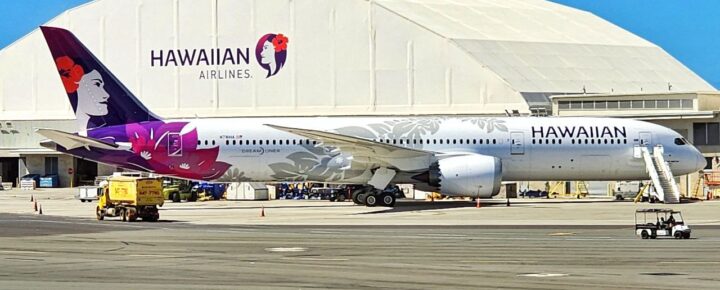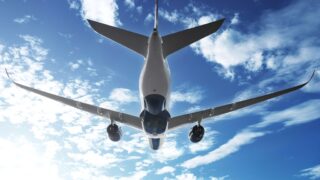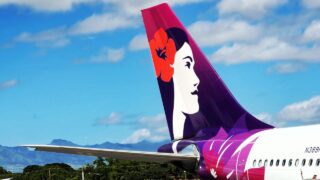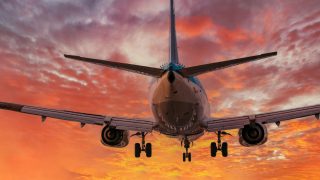The recent merger between Alaska Airlines and Hawaiian Airlines prompts significant speculation about what’s next for Hawaii’s flagship carrier.
One key question is whether Hawaiian Airlines’ widebody aircraft fleet, consisting of Airbus A330s and the newly introduced Boeing 787s (pictured), will remain in Hawaii or over time be transferred to Alaska’s network based in Seattle.
Hawaiian Airlines has long been crucial in connecting Hawaii to mainland U.S. and international destinations. These widebody jets enable direct flights to North America, Asia, Australia, and the South Pacific, providing access to both visitors and residents.
Now, as Alaska Air Group evaluates the potential profitability of Hawaiian’s operations, Hawaii faces the prospect of losing a valuable asset that has supported its tourism industry for decades: its widebody jets.
Hawaiian Airlines’ widebody fleet: Hawaii’s vital resource.
Hawaiian Airlines’ widebody planes include 24 decade-old Airbus A330-200s and two recently added Boeing 787-9s. These are the workhorses of the airline’s long-haul operations, with the fleet of 18 narrow-body A321neo planes.
If Alaska Air Group decides to reassign some of these widebody aircraft, currently numbered at 26, to its Seattle hub, Hawaii could lose some capacity to serve these crucial markets. These could be replaced with Boeing 737 MAX planes, which, together with its legacy 737 planes, are the mainstay of the Alaska Airlines fleet.
The unique role of Hawaii’s Pacific hub.
Hawaii has long been a gateway between the U.S. mainland and the broader Asia-Pacific region. Honolulu International Airport serves as a vital hub for tourists, residents, and commerce. Hawaiian Airlines has capitalized on its geographical advantage by offering direct widebody flights to cities in Japan, South Korea, and Australia, among others.
The merger, however, is poised to mix up the Hawaiian Airlines fleet. While Alaska Airlines has committed to maintaining the Hawaiian brand, the question remains whether it will continue prioritizing Hawaii’s needs like standalone Hawaiian Airlines once did.
If some of Hawaiian Airlines’ widebody planes are redirected to Seattle, likely for new international routes, it isn’t entirely clear how Hawaiian will serve destinations beyond the reach of its A321neo fleet.
How can Alaska Air Group keep Hawaii’s needs at the forefront?
Alaska Air faces a delicate balancing act in Hawaii. On the one hand, the company needs to improve Hawaiian Airlines’ dismal financial performance, which had put the airline on the verge of bankruptcy prior to Alaska’s purchase. At the same time, Alaska must consider the broader impact on Hawaii if Hawaiian’s widebody planes are reassigned to Alaska’s Seattle-based operations.
Alaska Air Group’s recent decision to hire an International Development Director suggests that the company is serious about expanding its long-haul operations. However, could this move come at a cost to Hawaii if it results in the transfer of Hawaiian’s widebody aircraft out of the islands?
Alaska’s expertise in aircraft deployment.
Alaska Airlines is adept at deploying the most efficient aircraft for each route, as will undoubtedly be the case in Hawaii. Recently, for example, they swapped out their smaller Embraer E175 jets with larger Boeing 737 planes on a Seattle to California route. That move accommodated increased demand while allowing them to operate with greater efficiency.
As Alaska Air integrates Hawaiian Airlines, this proven ability to optimize fleet deployment could play a role in determining how Hawaiian’s wide-body planes are utilized—whether those stay in Hawaii or are repurposed for distant markets. That won’t happen overnight, and there are issues that Alaska will need to navigate including Seattle gate constraints.
The Alaska Airlines-Hawaiian Airlines merger comes with opportunities and risks.
While Alaska Airlines will undoubtedly look to improve Hawaiian Air’s financial situation significantly, it must also carefully consider the potential consequences for Hawaii operations if widebody aircraft are shifted away from Honolulu.
Hawaiian Airlines has been a cornerstone of Hawaii’s travel and tourism industry, and the widebody fleet has played a crucial role in maintaining Hawaii’s connectivity to the world.
The future of Hawaiian Airlines’ widebody fleet remains uncertain for the time being. However, one thing is clear: Hawaii has much to lose if these planes “fly the coop,” and Alaska Air Group will need to tread carefully to avoid grounding Hawaii’s tourism industry.
We welcome your thoughts on the Hawaiian Air widebody fleet.
Get Breaking Hawaii Travel News







I used to work in the Alaska Airlines call center fielding complaints about things like 3 seats together. After some words of comfort and doing what I could I would usually end the call thinking (but never saying) “Well, it still beats walking,” or swimming in the case of flights to the islands.
We have every reason to think they will simplify the fleet. We just don’t know how.
The new 787’s would sell quickly. But they are the newest and best.
The A321neo’s are marketable, and Alaskan sold former Virgin airplanes to American. But Hawaiian bought what has proven to be the less-desirable engines. (But it still has lots of other users).
The A330’s are a harder call. Still in broad use, but not the star of the fleet.
The B717’s are perfect for their inter-island nitch, but are an aging orphan aircraft pre-merger Hawaiian had marked for replacement. It is just none of the potential replacements are a perfect match. Either or any would be smaller or larger and imply frequency changes. (But oddly, if Delta and Qantas go through with announced 717 retirement; there might be a new source of used parts).
I recently flew Alaskan kona to sea tac. Flew back Hawaiian Portland to Honolulu. There is no comparing, Hawaiian was much better wide bodied plane and service too. Lynn
My BF and I always travel to Las Vegas on the A330 bc the main cabin is 2-4-2. The narrow body planes are 3-3 configuration meaning we have to sit next to a stranger who would have climb over us to go to restroom. Very inconvenient. I know a lot of people hate the 3-3 seating. Please keep the A330.
It’s so amusing to read people talking about the fact that they love the wide body service Hawaiian offered for the mainland. Yeah it was spacious, that’s also why they went out of business. Same old traveling public, same old United States, they want $1,000 worth of services for $50
I believe the wide bodies should be kept. They are the crown jewel of Hawaiians fleet. Pax would rather fly wide bodies and not be cramped in the Max or A321s. Hawaiian is a subcontractor for Amazon in Hawaii so how can they get rid if the converted A330 freighters?
Alaska has a history. And it doesn’t look good for the A330s and 321s.
They bought Virgin just to take their LA and East Coast operations and got rid of all the Airbus planes
Whether or not people like flying a wide body and no matter what contract Hawaiian currently has, Alaska only cares about delivering dividends to shareholders and making money, it’s what companies do. I do not believe that there will be any consideration aside from an economic one. Alaska’s history is too be very shrewd and not go out on a limb unless a return is guaranteed. They do not want Hawaiian as an asset, they want Hawaiian to be gone so that they can have the gates,routes and facilities. Except interisland, they don’t want those at all.
I think the gloom and doom in the comments are not warranted by the facts. Let’s not forget that DOT approval has set certain requirements for the merger such that AS cannot subsume HA as it did Virgin America –and I don’t think it wants to. Ditto for ditching interisland services–that is covered in the DOT approval, too. Yes, a new administration could change that I suppose, but why would they?
Personally, I love the idea of being able to connect to Australia via HNL rather than SFO or LAX on a widebody. I don’t think AS is a threat to that but Qantas has been talking for some time about adding SEA-SYD nonstops and Air Tahiti Nui already flies nonstop SEA-PPT. That’s your real competition.
If those widebody jets didn’t make a profit they will be gone. Didn’t count on Alaska to do anything except what is in the shareholders interest. As soon they don’t have to keep flying unprofitable interisland flights, they will stop. As soon as the AS board decides that keeping the two brands separate costs too much, Hawaiian will be gone.
I can’t imagine they will keep Hawaii to Australia/NZ/ com Islands flights, that just doesn’t factor into their business model. Japan maybe but probably not from HNL. Alaska isn’t going to actively preserve the Hawaiian brand 10 minutes longer than they are contractually obligated to do so. They didn’t care about Virgin America although they said they did…. And they don’t care about Hawaiian. They also didn’t need to buy an ailing, indebted airline to get a few widebody jets and international routes. Alaska is a savvy company but they aren’t known for being charitable if it loses them money.
I am positive if Alaska airlines cancels using the 787 wide body from the west coast will lose me as patron. I typically purchase 8 to 10 round trip first class seats. Without the lie flat seats they don’t have a livery product that can out perform thr other US carriers. This goes for at least 30 people I know that travel regularly to the Islands.
As a passenger flying to Hawaii, I have had the choice of HawaiianAirlines wide body Airbus, Alaska Airlines 737’s. My preference for the 5 – 6 hour flight is the Airbus! Plus, Hawaiian has always made you feel as if you are in the islands. Alaska, please keep the Airbus planes and fly them from the west coast to Hawaii. I also have flown international from HNL to New Zealand/Australia.
This was all predictable, Alaska is a Boeing Airline with 737, they now have access to the A330’s, which increase capacity in the Continental USA, which aside from Boston, NYC, opens the door for Atlanta, Orlando, Miami. Having begun travel to Hawaii 1986, initially LAX, now PHX, Delta’s Wide-body L-1011’s necessitated the commute into LA, when that was retired and they went to a 767, everything changed, the Luxury of 2X2, and then in the new Millennia we switched to Hawaiian and the Wide-body in First. The 737 regardless of to Hawaii, Miami (AA out of PHX) or where-ever is ‘Steerage’, it may fit the Price pocketbook, but there is no Luxury, regardless of Class of Service! One can see Alaska filling 737’s Sea-Tac or PDX to Hono.. a sad ending for a great Carrier, in Hawaiian Airlines.
Hawaiian flew to Orlando but that didn’t last long,
These airlines are not in the position to provide Hawaii with any comfort favors. It’s all about making money and making it affordable to operate the service. Hawaii should be glad they have any inter island flight let alone the type of comfort associated. Just feel glad the service is still available. Fly or don’t fly but quit complaining about it. The real reality is pay or don’t pay and if you don’t pay I guess you are just stuck on the island until you fork up the money. Someday the loss will out weight the service and inter island commercial travel could be extinct.
If I had to guess, AS/HA will only use A330’s and 787’s on routes that have direct widebody competition from AA/UA/DL, e.g. large mainland cities. They will otherwise use them to grow tourism-heavy routes that cannot be served by 737’s and A321’s, e.g. large Pacific Rim cities. I bet SEA loses its A330’s to OGG and HNL, for example.
Travelers **should** expect aircraft type and schedule changes to/from HNL. However, I don’t think Alaska is going to abandon many, if any, Asia/Pacific destinations from HNL (e.g., Japan, Sydney, etc., however, with maybe a SEA-HNL-SYD schedule?) However, I would think that some other locations might see 737 MAX flights. For example, Papeete (PPT) is 2,700 miles from HNL. That’s well within a 737 MAX range (3,300-3,800 miles), so you could see a change in aircraft. On the upside for that route, maybe it gets flown more than once a week (currently only Saturdays). While I’m sure there will be disappointments in route/aircraft/frequency changes under Alaska, there may be some nice nuggets, too. While I don’t see the demand, a HNL-MEX (Mexico City, an Alaska Airlines served city) is within the range of 737 MAX. Ballet Folklorico anyone?
The main reason I fly Hawaiian from Seattle to Hawaii is the wide body aircraft that allows me to have only 2 seats together avoiding a middle seat. Alaska flights to Hawaii are single aisle with a seating configuration of 3 and 3.
Farewell to Hawaii’s widebody aircraft. Those widebody aircraft will likely be reassigned to Seattle and repurposed. Alaska has a lot of clout at SEA. Although the Alaska Air Group appears “sentimental” about Hawaii and it’s tourism, it’s only a small part of the picture. It will dig Hawaiian Airlines out of the hole with efficiency and tough decisions at the expense of Hawaii residents. Besides, what other choices would we, Hawaii residents have, if we need to fly a narrow-body plane to make a connection to somewhere. We don’t have much choices.
Alaska Airlines has neither the facilities nor the inclination to use Hawaiian’s widebodies on current Alaska routes.
They have no gates in SEA that would accommodate widebodies, nor maintenance facilities, nor room in their existing facilities for widebodies.
But the better indicator is what airline flies widebodies out of Seattle on domestic routes.
The Hawaiian widebodies are basically used for East Coast to Hawaii routes that are too long for A321’s, and Hawaii to Asia/South Pacific.
Perhaps Hawaiian will sell their South Pacific routes to United to fold into its former Air Micronesia operation.
AAG would be foolish to move the wide bodies out of Hawaii. HA already has a well established maintenance base and program there in Hawaii. Training the AS mechanics on the two airframes alone would cost money and time, Solely using the MAX is a very bad and unsafe idea. We have always enjoyed flying on HA’s A330’s and hope to fly on the Dreamliner to Hawaii soon. Alaska management doesn’t need to mettle in things that should be left alone
My family and I are Hawai’i residents and have flown on Hawaiian Airlines wide body aircraft exclusively between Honolulu and the mainland for many years. We have never flown on Hawaiian’s A321neo fleet to the mainland and If Alaska Airlines discontinues wide body service to the west coast destinations and begins flying those routes with 737 service only, then we will change to another airline that offers wide body service. We prefer the comfort and ride that wide body jets offer. We are loyal Hawaiian customers, but getting rid of wide body service to the west coast is a deal breaker for us.
I do not care for the 3 across seats.
Can only hope they keep the wide body for the nonstop 11 hour BOS/HNL route. At the moment there are no other nonstop options. But, as you’ve reported, Delta will start seasonal nonstop service next month. The Delta option will be superior to Hawaii’s somewhat tired aircraft unless they start using the 787 Dreamliner.
How will Delta’s service be superior? Which aircraft do they plan on using for the route you mentioned?
I can see a drop of the HNL-BOS non-stop flight entirely and replaced by an HNL-SEA-BOS connecting flight (probably a change of planes in SEA to Alaska). As for Delta, the last time I flew to LAX on Delta, it was a decrepit 767 interior where the audio jacks didn’t work and the charging ports were so loose that one could not get an electrical connection.
It is very unlikely the widebodies fly the coop at least for a while. For one thing SEA is very gate constrained especially in the widebody category. In the North satellite, Alaska’s primary gate block, there is only one widebody gate and using that blocks off 2 narrowbody gate.
You may see some mainland tag routes, ie HNL-SEA-JFK or HNL-SEA-ANC to increase the WB utilization but probably not much more that that initially.
@Greg–you are definitely onto something here.
At present, HA operates out of the S gates at SEA. There are many more widebody gates in the A and S concourses than elsewhere at SEA airport. AS uses C, D, and N concourses, with only occasional international arrivals at S–after which the plane has to be towed to a C, D, or N gate for the next departure, at least in some cases.
A, B,(not widebody capable) and S concourses are Delta territory, although S houses a lot of other international carriers at shared gates. I don’t see DL ceding any gates to its biggest competitor at SEA.
I also think AS has to be very careful about expanding to international destinations out of SEA. There is already a lot of competition from DL as well as foreign carriers. And let’s not forget that in acquiring HA, DL paid $1 billion in cash and assumed $900 million of HA debt. That’s a lot of risk already, even without new SEA routes